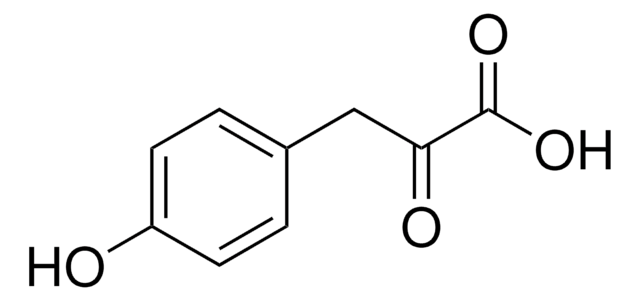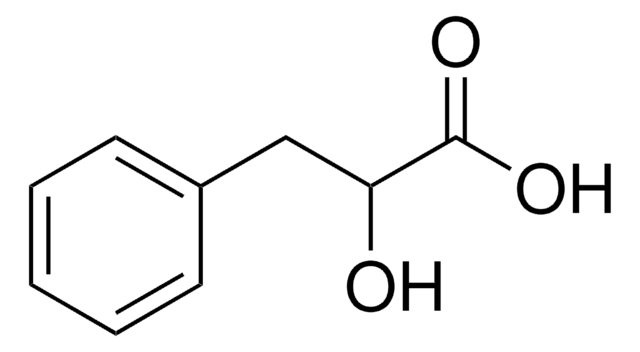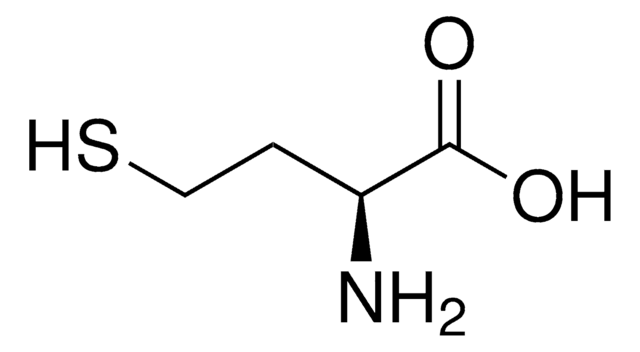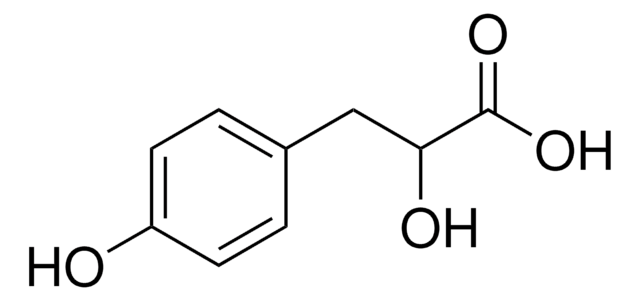P8001
Sodium phenylpyruvate
powder
Synonym(s):
2-Oxo-3-phenylpropanoic acid, Phenylpyruvic acid sodium salt
Sign Into View Organizational & Contract Pricing
All Photos(3)
About This Item
Linear Formula:
C6H5CH2COCOONa
CAS Number:
Molecular Weight:
186.14
Beilstein:
4770978
EC Number:
MDL number:
UNSPSC Code:
12352100
PubChem Substance ID:
NACRES:
NA.22
Recommended Products
form
powder
color
white to off-white
mp
>300 °C (lit.)
storage temp.
2-8°C
SMILES string
[Na+].[O-]C(=O)C(=O)Cc1ccccc1
InChI
1S/C9H8O3.Na/c10-8(9(11)12)6-7-4-2-1-3-5-7;/h1-5H,6H2,(H,11,12);/q;+1/p-1
InChI key
MQGYVGKMCRDEAF-UHFFFAOYSA-M
Looking for similar products? Visit Product Comparison Guide
Storage Class Code
11 - Combustible Solids
WGK
WGK 3
Flash Point(F)
Not applicable
Flash Point(C)
Not applicable
Personal Protective Equipment
dust mask type N95 (US), Eyeshields, Gloves
Choose from one of the most recent versions:
Already Own This Product?
Find documentation for the products that you have recently purchased in the Document Library.
Customers Also Viewed
Jun Wang et al.
Frontiers in microbiology, 10, 2357-2357 (2019-11-05)
Endogenous hydrogen sulfide (H2S), which is primarily generated by 3-mercaptopyruvate sulfurtransferase (3-MST) in Escherichia coli (E. coli) under aerobic conditions, renders bacteria highly resistant to oxidative stress. However, the biosynthetic pathway and physiological role of this gas under anaerobic conditions
William M Moe et al.
Environmental science & technology, 52(16), 9311-9319 (2018-07-26)
In situ bioremediation practices that include subsurface addition of fermentable electron donors to stimulate reductive dechlorination by anaerobic bacteria have become widely employed to combat chlorinated solvent contamination in groundwater. At a contaminated site located near Baton Rouge, Louisiana (USA)
Cristiana M L Di Giuro et al.
PloS one, 8(7), e68932-e68932 (2013-08-13)
(S)-Hydroxymandelate synthase (Hms) is a nonheme Fe(II) dependent dioxygenase that catalyzes the oxidation of 4-hydroxyphenylpyruvate to (S)-4-hydroxymandelate by molecular oxygen. In this work, the substrate promiscuity of Hms is characterized in order to assess its potential for the biosynthesis of
Taiki Fujii et al.
Biochimica et biophysica acta, 1814(12), 1669-1676 (2011-06-16)
We discovered the phenyllactate (PLA)-producing fungal strain Wickerhamia fluorescens TK1 and purified phenylpyruvate reductase (PPR) from fungal cell-free extracts. The PPR used both NADPH and NADH as cofactors with more preference for the former. The enzyme reaction as well as
A Hargreaves et al.
Journal of photochemistry and photobiology. B, Biology, 89(2-3), 110-116 (2007-11-06)
Ultraviolet A (UVA) light (315-400 nm) is ubiquitously found in our environment and constitutes about 95% of the total solar UV; all UVC and most UVB being absorbed by the stratospheric ozone layer. Compared with UVB and C, UVA does
Our team of scientists has experience in all areas of research including Life Science, Material Science, Chemical Synthesis, Chromatography, Analytical and many others.
Contact Technical Service











